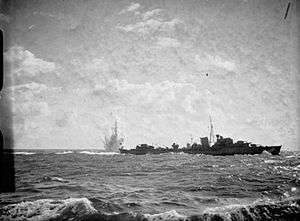HMS Jaguar (F34)
 Jaguar dropping depth charges, 1940 | |
| History | |
|---|---|
| Name: | Jaguar |
| Namesake: | Jaguar |
| Builder: | William Denny and Brothers |
| Laid down: | 25 November 1937 |
| Launched: | 22 November 1938 |
| Commissioned: | 12 September 1939 |
| Identification: | Pennant number: F34 |
| Fate: | Sunk by German submarine U-652, 26 March 1942 |
| General characteristics (as built) | |
| Class and type: | J-class destroyer |
| Displacement: | |
| Length: | 356 ft 6 in (108.66 m) o/a |
| Beam: | 35 ft 9 in (10.90 m) |
| Draught: | 12 ft 6 in (3.81 m) (deep) |
| Installed power: |
|
| Propulsion: | 2 × shafts; 2 × geared steam turbines |
| Speed: | 36 knots (67 km/h; 41 mph) |
| Range: | 5,500 nmi (10,200 km; 6,300 mi) at 15 knots (28 km/h; 17 mph) |
| Complement: | 183 (218 for flotilla leaders) |
| Sensors and processing systems: | ASDIC |
| Armament: |
|
HMS Jaguar was a J-class destroyer of the Royal Navy.
Construction
The eight ships of the J-class were ordered on 25 March 1937, and Jaguar was laid down at the Dumbarton shipyard of Denny on 25 November 1937. She was launched on 22 November 1938 and commissioned on 12 September 1939.[1]
Jaguar was 339 feet 6 inches (103.48 m) long between perpendiculars and 356 feet 6 inches (108.66 m) overall, with a beam of 35 feet 8 inches (10.87 m) and a draught of 9 feet (2.7 m). Displacement was 1,690 long tons (1,720 t) standard and 2,330 long tons (2,370 t) deep load.[2] Two Admiralty three-drum boilers fed steam at 300 pounds per square inch (2,100 kPa) and 620 °F (327 °C) to Parsons to two sets of Parsons single-reduction geared-steam turbines, rated at 40,000 shaft horsepower (30,000 kW). This gave a design speed of 36 knots (67 km/h; 41 mph) at trials displacement and 32 knots (59 km/h; 37 mph) at full load.[3]
As completed, Jaguar had a main gun armament of six 4.7 in (120 mm) QF Mark XII guns in three twin mountings, two forward and one aft. These guns could only elevate to an angle of 40 degrees, and so were of limited use in the anti-aircraft role, while the aft mount was arranged so that it could fire forwards over the ship's superstructure to maximise the forward firing firepower, but was therefore incapable of firing directly aft. A short range anti-aircraft armament of a four-barrelled 2 pounder "pom-pom" anti-aircraft mount and eight .50 in machine guns in two quadruple mounts was fitted, while torpedo armament consisted of ten 21 inches (533 mm) torpedo tubes in two quintuple mounts.[4]
Service
On commissioning, Jaguar joined the 7th Destroyer Flotilla based at Grimsby, operating off Britain's east coast. On 11 October, the ship ran aground in the Firth of Forth and was under repair until November.[5] In May 1940, during Operation Dynamo, Jaguar and other destroyers rescued survivors from the sinking of SS Abukir.[6][7]
In later February 1941 she took part in Operation Abstention, where she engaged the Italian destroyer Crispi off Kastelorizo, disengaging after Crispi scored a 40 mm (1.6 in) hit on her searchlight; that March she took part in the Battle of Cape Matapan. Jaguar was struck by two torpedoes fired by the German submarine U-652 and sank off Sidi Barrani, Egypt, 31°53′N 26°18′E / 31.883°N 26.300°E on 26 March 1942 with the loss of 3 officers and 190 of her crew. 8 officers and 45 crewmen were rescued by the naval whaler HMS Klo.
Notes
- ↑ English 2001, p. 71.
- ↑ Whitley 2000, p. 117.
- ↑ Lenton 1970, p. 121.
- ↑ Whitley 2000, p. 117–118.
- ↑ English 2000, p. 73.
- ↑ Mason, Geoffrey B (2004). Smith, Gordon, ed. "HMS Codrington (D 65) – A-class Flotilla Leader". Service Histories of Royal Navy Warships in World War 2. Retrieved 17 December 2013.
- ↑ Mason, Geoffrey B (2004). Smith, Gordon, ed. "HMS Grenade (H 86) – G-class Destroyer". Service Histories of Royal Navy Warships in World War 2. Retrieved 17 December 2013.
References
- Colledge, J. J.; Warlow, Ben (2006) [1969]. Ships of the Royal Navy: The Complete Record of all Fighting Ships of the Royal Navy (Rev. ed.). London: Chatham Publishing. ISBN 978-1-86176-281-8. OCLC 67375475.
- English, John (2001). Afridi to Nizam: British Fleet Destroyers 1937–43. Gravesend, Kent: World Ship Society. ISBN 0-905617-64-9.
- Friedman, Norman (2006). British Destroyers & Frigates: The Second World War and After. Annapolis, Maryland: Naval Institute Press. ISBN 1-86176-137-6.
- Hodges, Peter; Friedman, Norman (1979). Destroyer Weapons of World War 2. Greenwich: Conway Maritime Press. ISBN 978-0-85177-137-3.
- Langtree, Charles (2002). The Kelly's: British J, K, and N Class Destroyers of World War II. Annapolis, Maryland: Naval Institute Press. ISBN 1-55750-422-9.
- Lenton, H. T. (1998). British & Empire Warships of the Second World War. Annapolis, Maryland: Naval Institute Press. ISBN 1-55750-048-7.
- March, Edgar J. (1966). British Destroyers: A History of Development, 1892–1953; Drawn by Admiralty Permission From Official Records & Returns, Ships' Covers & Building Plans. London: Seeley Service. OCLC 164893555.
- Rohwer, Jürgen (2005). Chronology of the War at Sea 1939–1945: The Naval History of World War Two (Third Revised ed.). Annapolis, Maryland: Naval Institute Press. ISBN 1-59114-119-2.
- Whitley, M. J. (2000). Destroyers of World War Two: An Illustrated Encyclopedia. London: Cassell & Co. ISBN 1-85409-521-8.
- Winser, John de D (1999). B.E.F. Ships Before, At and After Dunkirk. Gravesend: World Ship Society. ISBN 0-905617-91-6.
- "HMS Jaguar (F 43) of the Royal Navy". Uboat. Retrieved 26 March 2013.
External links
| Wikimedia Commons has media related to HMS Jaguar (F34). |